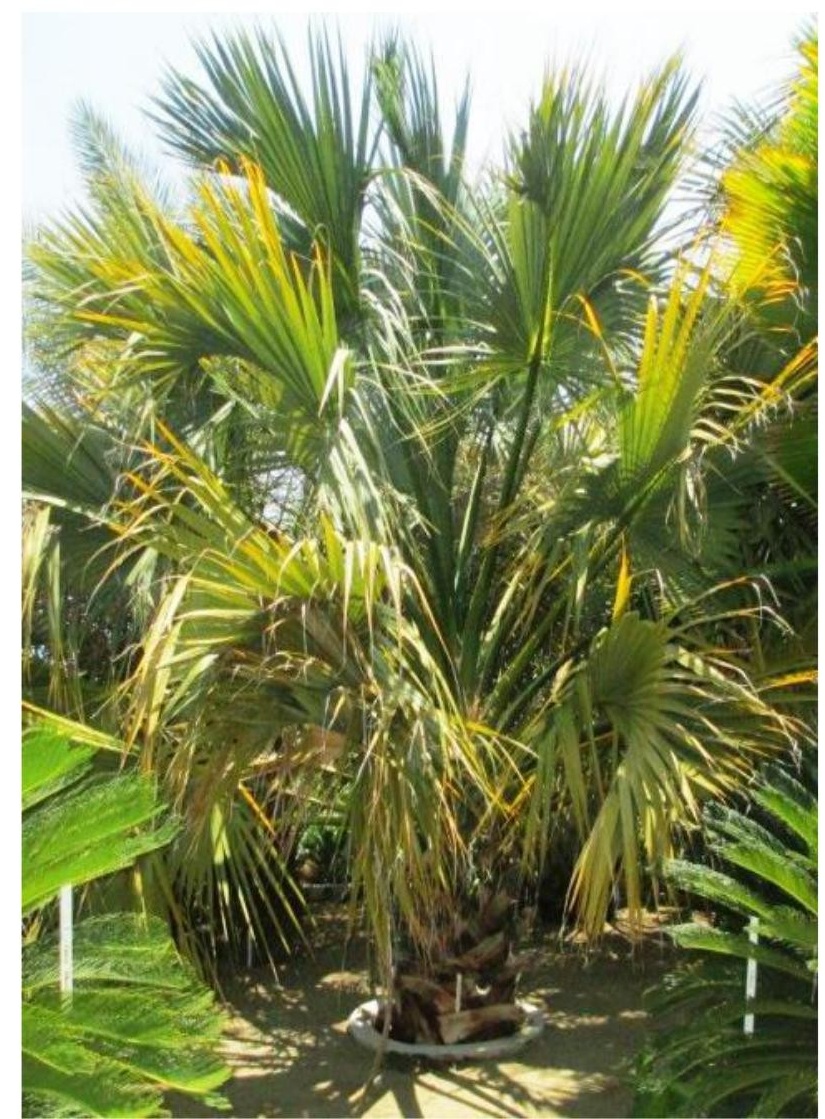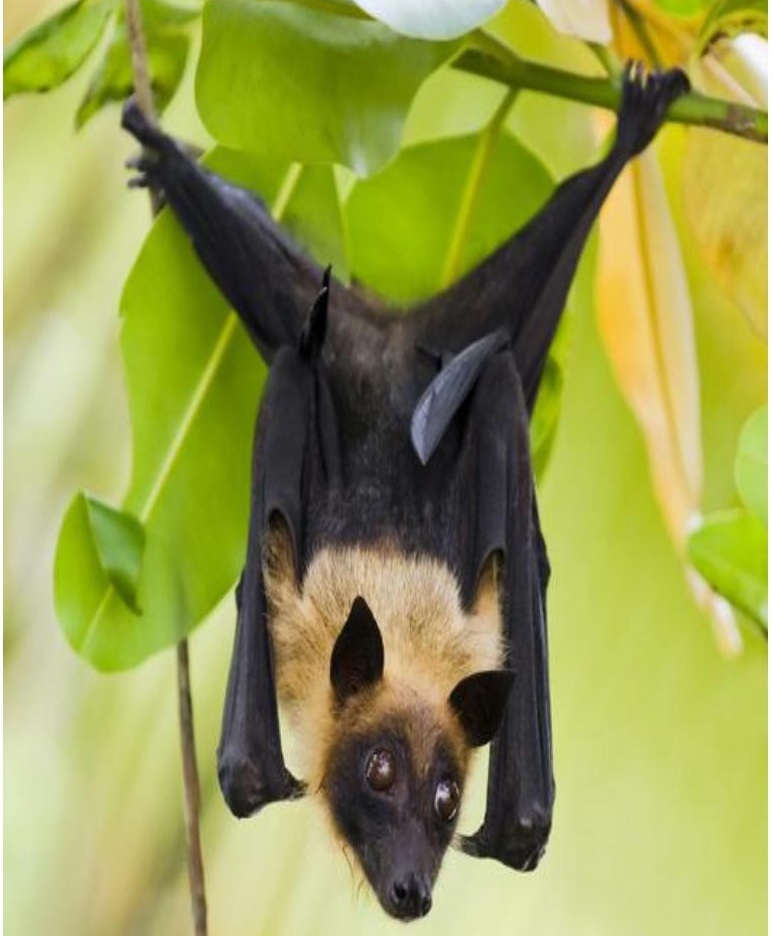By Tommy Clarkson from the October 2013 Edition

The featured (and loving it there) palm in the very center of the Heliconia Terrace – barely eight years old,is this fat trunked Mexican Palmetto.
Sabal mexicana
Family: Arecaceae
Also known as: Texas Palmetto, Texas Sabal Palm, Rio Grande Palmetto, Victoria Palmetto, and Palma de Mícharos
(The genus Sabal consists or fifteen (or so) different species. As a result of hybridization and similarity in appearance, as noted in the following, there is often confusion between them.)
The area of origin for the large, and very hardy, Mexican Palmetto stretches from the lower Rio Grande Valley of Texas south through the Atlantic and Pacific coasts of Mexico to Honduras, El Salvador and Guatemala. Once, in the Lone Star State, these beauties were much more wide-spread before extensive land clearing in the lower Rio Grande Valley all but decimated their numbers. Today, in the wild, they are relatively rare. In fact, their last native groves in Texas are in the Audubon Sabal Palm Grove Sanctuary in Cameron County.
Heading south, however, there are more. In that this genus is also the more common find, in and around the Caribbean region. Accordingly, one might assume the Mexican Palmetto to be rather easily identified. Not so. Few of my many tropical botanical books even have it listed. Possibly, that may come from the fact that it is closely related to the Maya Palm (Sabal guatemalensis). In fact, the two species as well as Sabal texana and Sabal exul -may be synonymous. Yet others might confuse it with the similarly appearing, and much more common, Cabbage Palm (Sabal palmetto) – the Florida State palm – which is a taller palm but with a smaller trunk.
No small palm, the Mexican Palm can grow to a height of 50 feet (15.24 meters) with a stout, robust trunk almost three feet (one meter) in diameter. The spread of a mature Mexican Palmetto may range from eight feet (2.4
meters) to 25 feet (7.6 meters). Its large, fan shaped (costapalmate) fronds reach a width of around three feet. The leaf is stout equaling or exceeding the leaf in length. Male and female flowers, produced on the same plant, are comprised of small, creamy white blooms on long inflorescences that branch to be as long as the frond stalks. From them come dark purple, round-oval fruits that hang in showy clusters and turn black when ripe. . . .
and really litter the ground below!
Unless cut off when the fronds have browned, the trunk will remain covered with old leaf stem (boots) that have split at their base. If fully removed, the trunk is gray in color. These boots form a characteristic and attractive crosshatch pattern on the trunk. (From our boot stubs grow orchids and air root bromeliads.) Its petioles (stems) are smooth and, thankfully, are completely thornless, growing up to 15 feet (4.6 m) in length.
The Mexican Palmetto robustly sports a crown of 10 to 25 fan-shaped leaves that may range in shades of green. The reason for this is the relativity of the amount of shade in which it grows and the amount of direct sunlight it receives. Hence, it may vary from a deep emerald green for those in shade to part shade, to a lighter green for those in more direct sun. Each of the large leaves have 80-115 leaflets with threads along the margins of the leaflets. These leaves appear to have a folded, three-dimensional look which stems from the fact that they have a prominent and strongly downward arching costa (leaf midrib).
Color of leaves notwithstanding, this palm thrives in partial shade/partial sun and full sun alike. Once established, it is drought resistant but will grow faster and have better overall looks if regularly watered. A plus over some other varieties of palms is that it tolerates wet locations and occasional flooding.
The fronds from this big old guy can be utilized for thatching, making chair seats, fans, and hat making. (These palms are plantation cultivated to be used as thatch in the Mexican Yucatan Peninsula.) Its rot resistant trunks are effectively employed as fence posts and even for wharf and pier pilings. Its fruit, called micharo, is edible.
Up north, this palmetto is more commonly called the Texas Palm as it is one of only two palms that are native to Texas – the other is the much smaller Dwarf Palmetto (Sabal minor).
This is not a palm for a small yard. It makes a rather assertive palm statement “I’m big and wish to be noticed” if my understanding of “Palm” is correct! But it is nice looking and has the additional bonus of being disease and pest free. . . . something I certainly aspire to maintain!

Sturdy stems, large fronds reaching out and up from a robust trunk are key features of this large palm from Mexico.

Download the full edition or view it online
—
Tommy Clarkson is a bit of a renaissance man. He’s lived and worked in locales as disparate as the 1.2 square mile island of Kwajalein to war-torn Iraq, from aboard he and Patty’s boat berthed out of Sea Bright, NJ to Thailand, Germany, Hawaii and Viet Nam; He’s taught classes and courses on creative writing and mass communications from the elementary grades to graduate level; He’s spoken to a wide array of meetings, conferences and assemblages on topics as varied as Buddhism, strategic marketing and tropical plants; In the latter category he and Patty’s recently book, “The Civilized Jungle” – written for the lay gardener – has been heralded as “the best tropical plant book in the last ten years”; And, according to Trip Advisor, their spectacular tropical creation – Ola Brisa Gardens – is the “Number One Tour destination in Manzanillo”.





You must be logged in to post a comment.